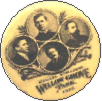|
|
One of the best and most complete sources for information about Pryor is contained in the Historical Notes included in the ARTHUR PRYOR Trombone Soloist of the Sousa Band, produced by Crystal Records CD451. 1
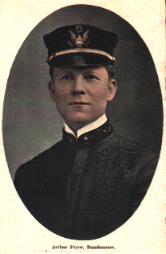
ARTHUR PRYOR (1870-1942)
"His execution set the prairies afire; His vibrating pedal tones rattled the windows of the Theatre and killed the gold fishes and stunned the canaries all the way out to the packing plant where even the iron gates trembled."
So said an exuberant newspaper reporter in Omaha. Nebraska, following a performance by the young trombone virtuoso Arthur Pryor. A later performance in Kansas City almost caused a riot when many in the crowd misunderstood Cries of "Pryor Pryor for "fire, fire." And so it went through the years when the Boy Wonder from Missouri was the featured star of John Philip Sousa's famous band.
Though Pryor gave up active public performance while in his forties. his activities as bandmaster and composer kept him in the public eye for most of the rest of his life. A household word for some three decades, Pryor's Band was second in fame only to that of Sousa's. Virtuoso performer. conductor, composer, arranger, teacher, and author, Arthur Pryor was, and continued to be, a major influence in American musical life.
Arthur Willard Pryor was born on September 22, 1870, on the second floor of the Lyceum Theatre, St. Joseph, Missouri. His father was the bandmaster of the town, and the family was living at the Theatre. Arthur was the second son born to Samuel D. and Mary (Coker) Pryor. The oldest son, Walter D. Pryor, became a famous cornetist who later "'as featured on recordings with the great Herbert L. Clarke. The youngest son. Samuel 0. Pryor, became known for his skill on the drums. playing in many Kansas City theatre orchestras. Both Walter and Sam Jr. later played in the famous Pryor Band their brother Arthur directed.
Being raised in this band environment. it was natural that the Pryor boys would turn to music.
Arthur's training began when he was about six. His mother was a pianist, and he studied that instrument with a Professor Plato in town. What instruction he received on band instruments came from his father whose strict training included a wrap on the head with a violin bow if Arthur made a mistake. He was taught to play the violin, comet, alto horn, bass viol and the valve trombone. When he was 11 years old, he appeared with the band in Chicago billed as the "boy wonder" from Missouri on the valve trombone.
Soon after this, a tramp left a battered old slide trombone with Sam as payment for a debt. Young Arthur was fascinated with this instrument, the first one in St. Joseph, so Sam told him to take it out to the barn and learn to play it. For some time he tried to master the instrument without using any slide oil, and he played using only two positions. Later, he learned quite accidentally from a man in the town pool hall that there might be as many as seven positions. He found these, though his lack of opportunity to study with a good professional player apparently resulted in his forcing some tones with the slide in what many would have considered the wrong positions. Later, in the heyday of his performing fame, he made great use of these alternate and "false" positions. He could play so well, and incredibly fast, that it hardly mattered that the "proper" positions were not being used.
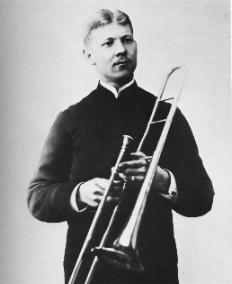
Soon Arthur Pryor became a featured member of his father's band. By this time he was obsessed with mastering his instrument. and later a boyhood friend named John White also a trombonist recalled that Arthur would practice hour after hour around 10 hours a day! By the time he was 15, Pryor was playing in county fairs in the area, and was becoming quite well known. In 1889 Allesandro Liberati, touring with the newly-organized band, stopped in Kansas City, and was told of the young virtuoso of St. Joseph. He took a trip there to visit with the Pryor family, and signed Arthur to appear as soloist with his band. They toured through the western states that summer. It was during this time that Pryor began to write the trombone solos that we know today. He was doing things on the instrument that had not been thought possible before, and no music was available that could demonstrate his skills.
In 1890, during a break from appearances with Liberati's Band, Pryor appeared with his father band in a concert in St. Louis. In the audience were members of the famed Gilmore Band. After hearing him perform "Rocked in the Cradle of the Deep", they rushed off to tell their leader about Pryor and the result was an offer to join that organization.
Instead,. Pryor went to Denver to direct the Stanley Opera Company. Why he passed up this opportunity to be soloist with Gilmore is not known. It is possible that he was influenced by the fact that his father had once been an opera director. Band historian Glenn Bridges thinks that he wanted to conduct and not travel so much. Another reason may be that he would have been following tile great Fred Innes as soloist, something his father had said no one could ever do. (By this time Innes had left Gilmore to form his own band.) in any case, according to the leading soprano of the opera company, Alice Neilsen, Pryor was successful as opera director. She was especially impressed with his ability as piano accompanist, both playing by ear, and for having an "endless repertoire" of songs that he knew. She recalled one incident where his kind encouragement kept her singing through a performance while caged lions (part of the following act) were snapping at her heels! Pryor claimed later that he learned through this opera experience the importance of knowing the piano; this aided him in his composing.
In 1892, John Philip Sousa's newly formed concert band made its first appearance in Plainfield, New Jersey. Tom Shannahan, who was one of many who left Gilmore to join the new Sousa Band, informed Sousa of Pryor's ability, and Sousa invited Pryor to audition for the band. Settled with his work in the opera company. Pryor was at first reluctant to leave. But he decided to accept Sousa's offer to see him in New York City, arriving there with his trombone and 35 cents. After spending a lonely night on a park bench in Union Square, he attended his first rehearsal. Even as he was warming up he made quite an impression. "We had never heard such tones come out of a trombone before, but fast!" trombonist Marc Lyons told Glenn Bridges years later. Lyons also recalled that at that first rehearsal, Frank Holton, then first trombonist, asked Pryor to play a difficult passage Holton had been having trouble with. After Pryor played it Sousa stopped the band and said, "Frank that is fine, and the first time you got it right. Frank stood up and said, "Mr. Sousa it wasn't me playing but this young fellow Pryor." Holton was ready to step down immediately, but Sousa asked him to stay on for a time, since "this young fellow may be just a flash." Holton reluctantly agreed to stay but left the band in the fall of 1893, and Pryor became first chain (In later years, Pryor was to endorse the trombones made by the Holton Company.)
Pryor was only 22 when he played his first solo with the Sousa Band during the World Columbian Exposition in Chicago in 1893. According to accounts of the day, he played his own "Thoughts of Love to a crowd who just stood in awe, then cheered and threw their hats in the air. That was the first of some 10,000 solos that Pryor estimated he played during the 12 years he was with the Sousa Band.
Arthur Pryor was a musician as well as a technician. Along with his phenomenal tonguing ability and lightning-fast slide technique, he was equally well-known for his beautiful tone and expressive style of playing. In fact, he actually preferred slow, lyric ballads and operatic arias to the fast, spell-binding display pieces that Sousa insisted he perform first. (For a third encore he often performed something like "Oh, Dry Those Tears", a sweet ballad which was his favorite.) His clean unforgettable tone was marked with a constant vibrato, the result of a boyhood accident when a mule kicked him in the face, resulting in partial paralysis. ("I wave it with my lower jaw", he once said.) The trombone had never had such a wide range before (he would demonstrate songs in four octaves), and pedal tones would come out of a 6 1/4 inch bell with all the ease of a modern symphony bass trombone. (His first trombone had a huge 9-inch bell according to H. W. Schwartz, Bands of America, pg. 200 . When he first joined Sousa he was down to 6 3/4 inch. but he later established 6 1/4 inch as his bell size, with a .458 bore, a small instrument even in that day.) He was also able to produce chords by playing one note, humming a note at a higher interval, and then encouraging the acoustical "different tone" to sound.
Through the years he was with Sousa he shared the spotlight with premier cornetist Herbert L. Clarke, who said of him, " His technique was wonderful greater than any clarinet player I ever heard. When we were together with Sousa I heard him play his solos twice daily for years hundreds of times, and never heard him miss a note in public. He was perfection in everything he did". A generation of trombonists have tried to imitate him, and the instrument has never been the same since.
From 1895 till 1903, Pryor was assistant conductor of the Sousa Band. In this capacity and as trombone soloist. Pryor traveled coast to coast and made three tours of Europe, playing before crowned heads of state. King Edward VII of England enjoyed one of Pryor's band compositions "The Coon Band Contest," so much that the King had it played at all court concerts there-after. The work was also a favorite of Kaiser Wilhelm of Prussia.
After a concert before 25,000 in Leipzig Germany, while on his last European tour members of the Gewandhaus Symphony Orchestra came backstage to inspect Pryor's trombone. Skeptical that an ordinary instrument could be played so fast they took the slide apart and peered down the mouthpiece. One of their trombonists said, "No one can play so well. It is a Yankee trick!" In Russia he was decorated by Czar Nicholas II. He was called the "Paganini of the trombone", in reference to the great Italian violinist Niccolo Paganini (1782-1840) who did change his instrument by altering string tunings to facilitate performance. Pryor would insist on getting in at least two hours of practice a day.
But while in Russia Pryor got into a salary dispute with Sousa. When the band returned home Pryor left to begin his own band in 1903. He and Sousa remained good friends, however, and Sousa's respect is captured in this quote by him: Nor was there anyone on earth to equal Arthur Pryor, the trombone player, when he was with my organization." Years later, Pryor served as a pallbearer at Sousa's funeral, and he helped in the planning of a memorial to his former leader.
Through the years with Sousa, Pryor performed with the band in many of the places he and his own band would later frequent. Besides directing the Sousa Band on occasion (he especially had to help them in 'feeling" the new jazz rhythms in his arrangements). He would also direct many of the recording sessions of the band. Sousa did not have an appreciation for the canned music" of the new recording industry, so he was more than willing to let Pryor and others direct the few number of his men who could manage to squeeze around the primitive recording horns in those days. While Herbert Clarke and another assistant named Henry Higgins directed often, it has been estimated that some 75% of the Sousa Band labels were conducted by Arthur Pryor. Most of these recordings were made for the Berliner and Victor labels, and while the conductors were not always indicated on the records, the 1900 Berliner catalogue, for example, does state that the band is performing "under the personal direction of Mr. Arthur Pryor, the great trombone soloist and assistant conductor to Mr. Sousa."
After securing and rehearsing his musicians, the Pryor Band presented their first concert in the Majestic Theatre, New York City on November 15,1903. For the next six years he established his band across the country as a major musical force in America, second in fame only to the Sousa Band. Some considered his band superior to Sousa's. He secured the finest performers and soloists he could find. The CD program notes list many of the performers featured with his band.
Six coast to coast tours between 1903 and 1909 brought his band before millions of admirers. In the 1904 season alone, Pryor directed his band in 269 concerts before a total audience estimated at no less than 300,000 people at Asbury Park, New Jersey. Some 2500 people would crowd into the Casino there to hear this great organization with its dashing young conductor. As an added treat, these early Pryor Band programs would usually include a Pryor trombone solo, though this was to change as time went by.
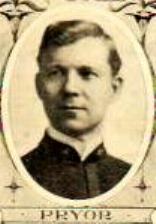
The Pryor Band played 11 seasons at Willow Grove Park north of Philadelphia, a high class recreation center where no man was allowed in without a coat even in summer. The longest time between visits there followed a rehearsal where a strongly worded encouragement to a member of the band happened to fall on the sensitive ears of a woman of influence at the Park! It was seven years before the beautiful, natural outdoor pavilion of "The Grove" echoed to the sounds of the Pryor Band again. When the Pryor Band did play there they, would usually be followed by the Sousa Band. Since both directors were baseball fans, the players would look forward to a friendly confrontation on the diamond during the short time they were there together.
The last tour of the Pryor Band was in 1909, and Pryor decided to settle down and make his permanent home in Asbury Park. He had been married since 1895 to Maud Russell, and they had two sons. During the years of travel, first as soloist arid their as conductor, he would try to spend tune in St. Joseph with his family, who had lived with Pryor's parents. The Pryor Band continued to play the various summer seasons at Willow Grove and Asbury Park, and winters in Miami, but in the off season it was busily engaged enlarging Victor's growing record catalogue.
Even before this time, in 1906, when the Pryor Band was still a touring organization, there were no less than 168 catalog numbers assigned to recordings of this very active ensemble. Much more than tone coloring would have been lost had not Pryor begun arranging music especially for recording purposes. He eliminated the delicate shadings and solidified the sound so that these early recordings would at least stress the essential elements of the music. He is considered a pioneer arranger in this respect. The selections included all the popular kinds of pieces of the day: marches, waltzes, gavottes, medleys, patriotic airs, fantasies, novelties, hymns, serenades, and paraphrases. Also included were transcriptions of operatic arias and overtures, along with cakewalks and rags which helped to introduce the new jazz age. It was a very productive and financially successful venture.
It may seem surprising that trombonists were among the soloists Pryor secured for Iris band. But in everything he was a perfectionist, and since he could no longer apply himself to practice, he gradually turned over the performance responsibilities to others. While he continued to play the trombone throughout his life, his greatest success as a performer was during his time with Sousa. Having thoroughly mastered his instrument early in life, he would not settle for anything less now (age 52). He had developed new musical interests which were taking his time, and his public performance was a thing of the past.
His standard of perfection continued on the podium. His legendary outbursts of temper spiced with an equally legendary tongue, caused him to be compared with Toscannni. But unlike the fiery Italian, the offense was forgotten as quickly as it had been noticed and the men in the band grew to accept this as a part of the routine. After the rehearsal he would enjoy friendly fellowship with all, including the offender, over drinks together. He knew he had a temper and was not proud of it. But, like Toscannni, it can be attributed to an extreme musical sensitivity, not ego. He once told a friend that pour playing actually caused a physical reaction in him. While conducting he lived the music being performed. As someone once wrote of him (quoted in Bands of America by Schwartz, p.282) "Music is his life the correct interpretation of it, his life blood boil beauty. his life breath." While mistakes in playing were an aversion to him and he did at times lose players because of his reaction, he was a very kind man and his men respected him for his friendship as well as his musicianship. Often when sharing meals together (which is something not every conductor did) the men would offer him a toast.
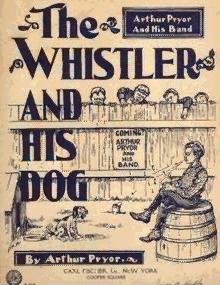
Pryor began composing solos for himself when he was with Liberati and went on to write many other compositions of all sorts including marches novelties waltzes and compositions in the early jazz style. He even wrote three comic operas and arranged a great deal of music, including a trombone solo of "Flight of the Bumble Bee!" While his trombone solos are all that are known today, in the days of his band's popularity his most popular number was "Whistler and his Dog", written in 1905.
Inspired by his boyhood pet bulldog named Roxy, the song included a very popular whistling strain and ended with a dog bark. In time Pryor got so tired of requests to play it that he wrote a piece called Sammy and his Missouri Mule which he hoped would take some of the attention from it. But Sammy had a whistling part too!
His great facility at composing grew out of his ability to improvise at the piano. He was able to take a three or four note motive and develop it into a theme for a composition He would also develop a theme from the rhythm and vowel sounds of a person's name. Throughout the years many favorites in the Pryor Band repertoire were Pryor compositions, so much so that at one point he had to make a public statement that he did not also w rite the popular pieces of John Philip Sousa!
In his promotion of the "healthy growth of our native music, he showed a fondness for the new jazz idiom. He had grown up along the Missouri River and with his father's show business contacts, had become acquainted with the traveling minstrel shows of the day St. Joseph is also near Sedalia, Missouri the birthplace of ragtime. He had developed a good "feel" for jazz, and many of his compositions are in this style. His "Razazza Mazzazza" is called the "king of rags" in the 1906 Victor catalogue. In 1919 he and his band introduced the popular "Swanee" by George Gershwin in a concert in New York City.
However. in all of his musical arrangements he should not add jazz style to a classical composition. While jazz is "legitimate entertainment" ("all right for dancing"), jazz versions of the old masters "have so confused the younger generation that youths put a swing rhythm into music when they think they are playing it straight." Because of this he once called jazz the "parasite of music," lacking originality except in the area of rhythm. He realized the concert band's contribution to American life ("they deserve credit for bringing the people closer to good music") and was saddened to see it supplanted by jazz ensembles as time went by. In the 1920s the Pryor Band moved into the area of radio broadcasting. By the early thirties he was associated with NBC for broadcasting in New York City. One popular series of concerts he and the Band did was called the Cavalcade of America..
He also found some time for teaching. He had a studio in the Life and Time Building, New York City; and also taught in his home in New Jersey. One former student, Prof. Matty Shiner of Duquesne University sums up his teaching standard in one word perfection". Through long tones, lip slurs and the study of arias and hymns he tried to develop in his students the concept of a singing style that he had introduced years before. As far as technical gymnastics "walk before you run!" -work out the parts slowly and steadily, and use lots of alternate positions. The lesson was "all business." He also would encourage young musicians to 20 on in their study. Dr. Leonard B. Smith, cornet soloist of the Goldman Band and conductor of the Detroit Concert Band, credits Pryor with persuading his father to allow him to go to New York to study music.
In 1933 the Pryors retired to their 27-acre farm named Driftwood near Long Branch New Jersey. The Pryor Band had spanned three decades of existence longer than that of any of the old traveling park bands except Sousa 5 The Pryors shared their home with the parents of their daughter in law By thi time the Pryor sons were well established and famous in their osvn right. Arthur Jr played the cornet and piano. performing and serving as assistant conductor for the Pryor Band. He was also an advertising executive. As Vice President for a New York-based company, he secured the talents of people like Kate Smith and Dinah Shore (and the Pryor Band) for the radio programs his company sponsored. Roger Pryor was a noted actor dance band leader radio personality. and husband of T.V. comedienne Ann Sothern. He secured his father's permission to use a swing arrangement of Whistler as his band's theme song
During retirement years the Pryors enjoyed working in their garden and keeping several dogs heirs to the famous Roxy. Maud Pryor was also an excellent pianist and we can be sure that she accompanied her husband as he demonstrated his skills for fortunate young musicians who would visit the home. He always kept his 1894 custom-made trombone on the shelf in his study for such purposes He also traveled to colleges to conduct band clinics. and wrote magazine articles on band betterment (such as "How to Play a March He even ran for public office in Monmouth Counts being elected as a Democrat to the board of freeholders on the platform of lower taxes He served only one term. keeping his promise to "enter and leave politics an honest man".
Sometimes he would get together the old Pryor Band (as mans members as he could find) for an engagement at nearby Asbury Park, scene of his earlier triumphs. It was after a rehearsal for such an
engagement, on the night of June 17, 1942. that he suffered a stroke (brain hemorrhage), and died at 5 AM the next morning. Arthur Jr., conducted the concert, which included his last composition. "We'll keep Old Glory Flying" dedicated to the U.S. Armed Forces. He was buried in Glenwood Cemetery near his home. He was an Episcopalian by faith, and he was a charter member of both the A.S.C.A.P (1914) and the American Bandmasters Association (1929).
In a tribute to the dying breed of self taught bandmasters following Pryor s death William Shaw of the Chicago Daily News wrote "As for Arthur Pryor, he came out of a family orchestra which played for the touring attractions that came to a Missouri theatre. Sam, the father played anything he turned his hand to, Sammy, a son, played drums, his brother Walter, cornet, Arthur, of course, went in for the sliphorn. Sousa heard him, hired him. He played 10,000 solos with Sousa's Band. His tone was as smooth and mellow as that of any singer; his fame for it, proverbial!
-----------------------
1 Crystal Records Inc., 28818 NE Hancock Rd, Camas, WA 98607
Biographical information by Daniel F. Frizane and Frederick P. Williams
Back to Arthur Pryor
Return to Performers
|
|
